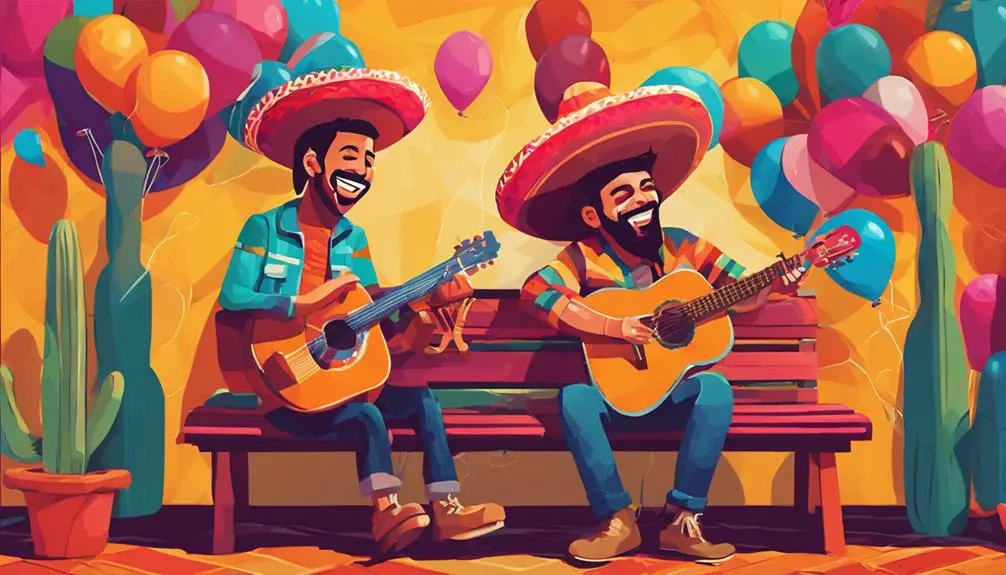When connecting with Spanish-speaking friends, mastering friendly slang expressions is key to building strong, authentic relationships. You can start with casual greetings like "¿Qué onda?" or "¿Cómo vas?" to set a friendly tone. Playful teasing with affectionate insults, using nicknames, and colloquial expressions like "¿Mande?" in Mexico or "Che" in Argentina can also help. Idioms like "tomar el pelo" or "estar la mar de…" are common in conversations and can add a layer of camaraderie. As you explore these expressions, you'll uncover the nuances of Latin American friendships and discover a world of playful banter, shared identity, and warm connections waiting to be made.
Casual Greetings With Amigos

When hanging out with amigos, you'll frequently hear casual greetings like '¿Qué onda?' or '¿Cómo vas?', which roughly translate to 'What's up?' or 'How's it going?' These greetings are an essential part of Spanish slang, and mastering them will make you sound like a native speaker.
In the morning, you might hear '¿Qué tal?' or 'Buenos días, ¿cómo estás?' as morning greetings. These casual greetings set the tone for a friendly and relaxed atmosphere.
In the evening, you might engage in evening catch-ups with your amigos, exchanging stories about your day or sharing laughter over a funny incident. You might hear '¿Qué has hecho hoy?' or '¿Qué tal la noche?' as evening greetings, which are more informal and conversational.
Using these casual greetings will help you build stronger bonds with your amigos and make you feel more connected to the Spanish-speaking community. By incorporating these greetings into your daily interactions, you'll be well on your way to sounding like a native Spanish speaker.
Teasing With Affectionate Insults
In Spanish-speaking cultures, you'll often find that amigos engage in playful teasing, throwing around affectionate insults like '¡Eres un vago!' or '¡Estás loco!' to show camaraderie and build rapport. This lighthearted banter is a common way to strengthen bonds and create a sense of belonging.
When you're part of the group, you'll likely receive (and dish out) playful jabs, all in the spirit of friendship. You might hear phrases like '¡Este tipo es unSleepy!' (this guy is so lazy!) or '¡Estás más loco que un perro!' (you're crazier than a dog!). Don't take it personally – it's all about the playful, tongue-in-cheek humor.
In fact, the more you can dish out sassy comebacks, the more you'll be seen as a valued member of the group. Remember, the goal is to have fun and show affection, not to genuinely insult. So, brush up on your witty retorts and get ready to engage in some playful teasing with your amigos!
Expressing Friendship With Nicknames

You'll often find that Spanish-speaking friends and acquaintances use nicknames, or 'apodos,' to express camaraderie and affection. This practice is deeply ingrained in Latin American culture, where nicknames are used to create a sense of belonging and closeness. When you're given a nickname, it's a sign that you're part of the inner circle. Nickname etiquette is vital, as it can make or break relationships. Using someone's nickname is a sign of respect and familiarity, while using their formal name can come across as distant or formal.
In Latin American culture, nicknames hold significant cultural significance. They're often used to poke fun at someone's physical characteristics, personality traits, or habits. For example, someone with curly hair might be called 'Rizado' (curly), while someone who's always late might be called 'Tardón' (latecomer). This lighthearted teasing is a way to build camaraderie and create a sense of togetherness.
Showing Solidarity With Colloquialisms
As you navigate the intricacies of Latin American friendships, colloquial expressions become a powerful tool to convey solidarity and togetherness.
You'll find that bonding phrases and community jargon are essential in building a sense of belonging. In many Latin American countries, using colloquialisms is a way to show you're part of the group, that you're 'in on the joke.'
For instance, in Mexico, you might use '¿Mande?' (What's up?) to show you're interested in someone's life. In Argentina, 'Che' (buddy) is a term used to address friends, implying a sense of camaraderie.
These expressions create a sense of shared identity and shared experiences, making you feel like you're part of the community.
By incorporating these colloquialisms into your conversations, you'll be showing your friends that you're committed to building strong relationships.
Building Camaraderie With Idioms

Using idioms is a great way to build camaraderie with your Latin American friends, as they often rely on shared cultural knowledge and humor to create a sense of togetherness. You'll find that idioms like 'tomar el pelo' (to tease or joke around) or 'estar la mar de…' (to be extremely… e.g., 'estar la mar de feliz' means to be extremely happy) are used frequently in everyday conversations.
Understanding the origins of these idioms can also give you insight into the cultural quirks of the region. For instance, 'tomar el pelo' originated from the idea of gently pulling someone's hair as a playful joke, highlighting the importance of playful teasing in Latin American cultures.
Frequently Asked Questions
Can I Use Slang With People I Don't Know Well?
When interacting with people you don't know well, it's crucial to be mindful of cultural boundaries and social norms.
You shouldn't use slang with strangers as it can come across as informal or even disrespectful. Wait until you've established a rapport and can gauge their comfort level with casual language. Even then, use slang sparingly to avoid misinterpretation.
Is Spanish Slang Different in Various Latin American Countries?
When you explore Spanish slang across Latin America, you'll find that regional dialects and cultural nuances shape the language.
You'll notice that each country has its unique flavor, reflecting local customs and history. For instance, Mexican slang is heavily influenced by indigenous languages, while Argentine slang has Italian and European roots.
You'll discover that Colombian slang is more rhythmic, whereas Dominican slang is more melodic.
As you investigate further, you'll uncover the rich diversity of Spanish slang across Latin America.
How Do I Know Which Slang Terms Are Offensive or Inappropriate?
Are you aware that cultural insensitivity can be just a mispronounced word away?
When exploring foreign slang, it's essential to take into account cultural nuance.
You shouldn't assume that what's acceptable in one region is universally okay.
Language evolution is constant, and what's trendy today might be offensive tomorrow.
Research the context, ask locals, and be mindful of power dynamics.
Can I Use Spanish Slang in Formal Writing or Professional Settings?
When considering using slang in formal writing or professional settings, you should exercise caution. While it may be tempting to add a touch of personality, slang can compromise Academic Acceptance and negatively impact your Professional Perception.
In general, it's best to stick with standard language to guarantee clarity and respect. Save slang for casual, social interactions, and maintain a professional tone in formal writing to make a strong, respectful impression.
Are There Any Universal Slang Terms Understood Across All Spanish Speakers?
You're curious if there are universal slang terms that resonate with all Spanish speakers. While it's challenging to find terms that transcend regional differences, some slang has gained widespread acceptance through social media, music, and cultural homogenization. Slang evolution is rapid, and what's popular in one region mightn't be in another.
However, certain terms like 'guay' (cool) or 'chido' (awesome) have become somewhat universal, understood across many Spanish-speaking countries.
Conclusion
As you navigate the world of Spanish slang, you'll find that being friendly takes on many forms.
Casual greetings with amigos become a warm embrace, teasing with affectionate insults a playful jab, and expressing friendship with nicknames a term of endearment.
Showing solidarity with colloquialisms and building camaraderie with idioms weave a tapestry of connection.
In this vibrant landscape, language becomes a gentle touch, a knowing glance, and a sense of belonging that wraps around you like a warm abrazo.







